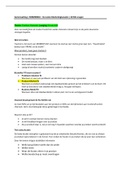Exam (elaborations)
Final Exam Study Guide - NUR2063 / NUR 2063 (Latest 2023 / 2024) : Essentials of Pathophysiology - Rasmussen
- Institution
- Rasmussen College
NUR2063 / NUR 2063 Essentials of Pathophysiology Final Exam Study Guide - Rasmussen University
[Show more]












